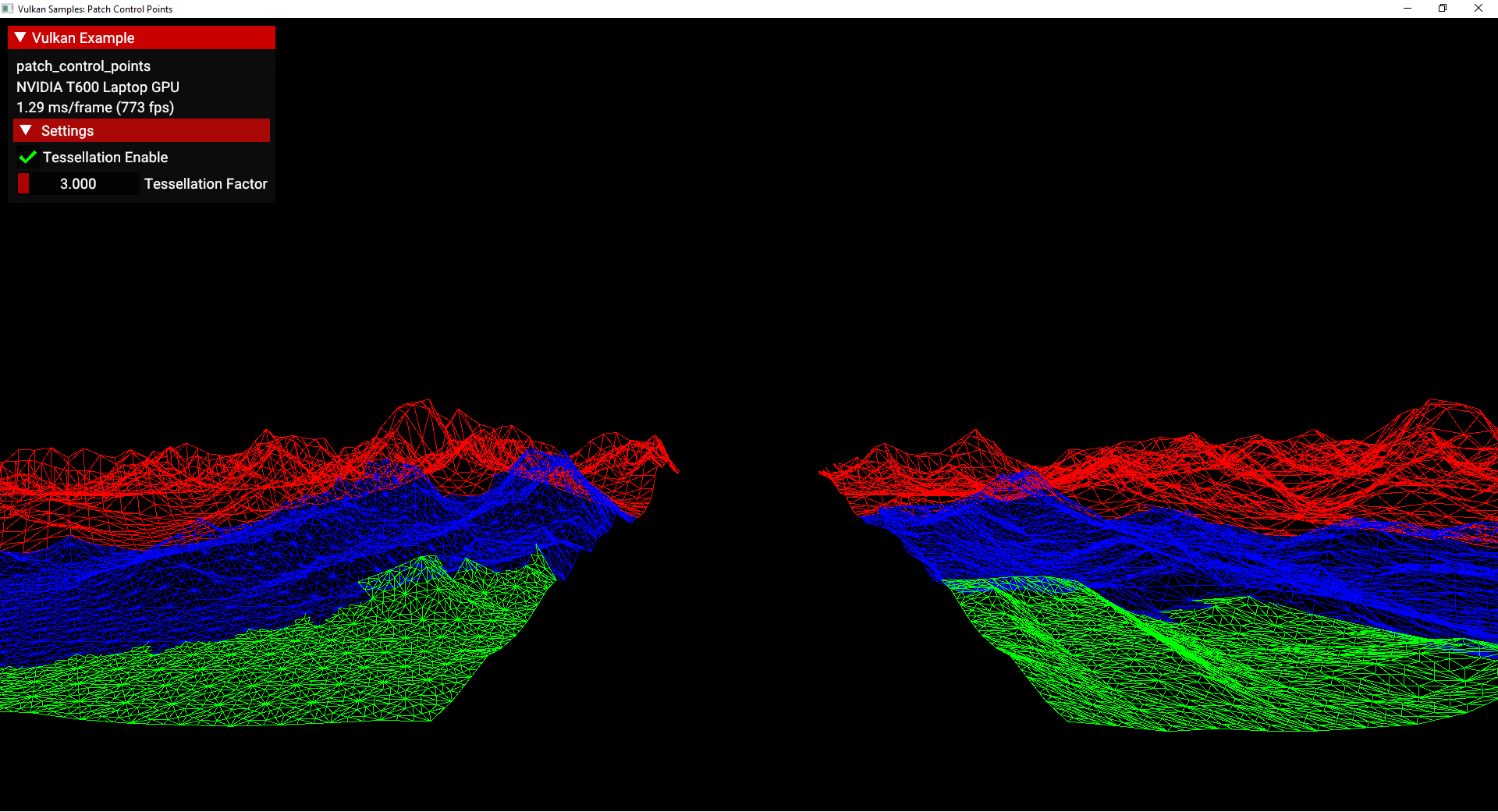Patch control point
| The source for this sample can be found in the Khronos Vulkan samples github repository. |

Overview
This sample demonstrates how to use VK_EXT_extended_dynamic_state2 extension, which eliminates the need to create multiple pipelines in case of specific different parameters.
This extension changes how Patch Control Points are managed. Instead of static description during pipeline creation, this extension allows developers to change the parameter by using a function before every draw.
Below is a comparison of common Vulkan static and dynamic setting of patch control points in the tessellation.
| Static/Non-dynamic | Dynamic State 2 |
|---|---|
dynamic_state = {VK_DYNAMIC_STATE_VIEWPORT, + VK_DYNAMIC_STATE_SCISSOR} |
dynamic_state = {VK_DYNAMIC_STATE_VIEWPORT, + VK_DYNAMIC_STATE_SCISSOR, + VK_DYNAMIC_STATE_PATCH_CONTROL_POINTS_EXT} |
VkPipelineTessellationStateCreateInfo tessellation_state{} + tessellation_state.sType = VK_STRUCTURE_TYPE_PIPELINE_TESSELLATION_STATE_CREATE_INFO + tessellation_state.patchControlPoints = patchControlPoints + … + vkCreateGraphicsPipelines(pipeline) |
vkCreateGraphicsPipelines(pipeline) |
draw(model, pipeline) |
vkCmdSetPatchControlPointsEXT(commandBuffer, patchControlPoints) + draw(model, pipeline) |
More details are provided in the sections that follow.
Pipelines
In the static approach to pipeline creation patch control points have to be defined while creating the pipeline. This is illustrated in a static/non-dynamic pipeline creation.
VkPipelineInputAssemblyStateCreateInfo input_assembly_state =
vkb::initializers::pipeline_input_assembly_state_create_info(
VK_PRIMITIVE_TOPOLOGY_PATCH_LIST,
0,
VK_FALSE);
VkPipelineTessellationStateCreateInfo tessellation_state =
vkb::initializers::pipeline_tessellation_state_create_info(3);
std::vector<VkDynamicState> dynamic_state_enables = {
VK_DYNAMIC_STATE_VIEWPORT,
VK_DYNAMIC_STATE_SCISSOR
};
VkPipelineDynamicStateCreateInfo dynamic_state =
vkb::initializers::pipeline_dynamic_state_create_info(
dynamic_state_enables.data(),
static_cast<uint32_t>(dynamic_state_enables.size()),
0);
VkGraphicsPipelineCreateInfo graphics_create{VK_STRUCTURE_TYPE_GRAPHICS_PIPELINE_CREATE_INFO};
graphics_create.pInputAssemblyState = &input_assembly_state;
graphics_create.pDynamicState = &dynamic_state;
graphics_create.pTessellationState = &tessellation_state;
graphics_create.layout = pipeline_layouts.statically_tessellation;
...
VK_CHECK(vkCreateGraphicsPipelines(get_device().get_handle(), pipeline_cache, 1, &graphics_create, VK_NULL_HANDLE, &pipeline.statically_tessellation));In the approach if developer would like to change the patch control points number, then for each different number a new pipeline would be required.
However, with VK_EXT_extended_dynamic_state2 the number of pipelines can be reduced by the possibility to change parameter Patch Control Points by calling vkCmdSetPatchControlPointsEXT before calling the draw_model method.
With the usage of above function we can reduce the number of pipelines.
Required dynamic states must be enabled and passed to the VkGraphicsPipelineCreateInfo structure.
By setting VK_PRIMITIVE_TOPOLOGY_PATCH_LIST in the VkPipelineInputAssemblyStateCreateInfo structure, the pipeline can use the patch control points functionality.
VkPipelineInputAssemblyStateCreateInfo input_assembly_state =
vkb::initializers::pipeline_input_assembly_state_create_info(
VK_PRIMITIVE_TOPOLOGY_PATCH_LIST,
0,
VK_FALSE);
std::vector<VkDynamicState> dynamic_state_enables = {
VK_DYNAMIC_STATE_VIEWPORT,
VK_DYNAMIC_STATE_SCISSOR,
VK_DYNAMIC_STATE_PATCH_CONTROL_POINTS_EXT,
};
VkPipelineDynamicStateCreateInfo dynamic_state =
vkb::initializers::pipeline_dynamic_state_create_info(
dynamic_state_enables.data(),
static_cast<uint32_t>(dynamic_state_enables.size()),
0);
VkGraphicsPipelineCreateInfo graphics_create{VK_STRUCTURE_TYPE_GRAPHICS_PIPELINE_CREATE_INFO};
graphics_create.pInputAssemblyState = &input_assembly_state;
graphics_create.pDynamicState = &dynamic_state;
graphics_create.layout = pipeline_layouts.dynamically_tessellation;
...
VK_CHECK(vkCreateGraphicsPipelines(get_device().get_handle(), pipeline_cache, 1, &graphics_create, VK_NULL_HANDLE, &pipeline.dynamically_tessellation));And now, thanks to VK_EXT_extended_dynamic_state2, we can change parameters before each corresponding draw call.
VK_CHECK(vkBeginCommandBuffer(draw_cmd_buffer, &command_begin));
...
/* Binding dynamically_tessellation pipeline and descriptor sets */
vkCmdBindDescriptorSets(draw_cmd_buffer,
VK_PIPELINE_BIND_POINT_GRAPHICS,
pipeline_layouts.dynamically_tessellation,
0,
1,
&descriptor_sets.dynamically_tessellation,
0,
nullptr);
vkCmdBindPipeline(draw_cmd_buffer, VK_PIPELINE_BIND_POINT_GRAPHICS, pipeline.dynamically_tessellation);
/* Set patch control points value */
vkCmdSetPatchControlPointsEXT(draw_cmd_buffer, patch_control_points_triangle);
/* Drawing scene with objects using tessellation feature */
draw_model(model, draw_cmd_buffer);
...
VK_CHECK(vkEndCommandBuffer(draw_cmd_buffer));Enabling the Extension
The extended dynamic state 2 API requires Vulkan 1.0 and the appropriate headers / SDK is required. This extension has been partially promoted to Vulkan 1.3.
The device extension is provided by VK_EXT_EXTENDED_DYNAMIC_STATE_2_EXTENSION_NAME.
It also requires VK_KHR_GET_PHYSICAL_DEVICE_PROPERTIES_2_EXTENSION_NAME instance extension to be enabled.
add_instance_extension(VK_KHR_GET_PHYSICAL_DEVICE_PROPERTIES_2_EXTENSION_NAME);
add_device_extension(VK_EXT_EXTENDED_DYNAMIC_STATE_2_EXTENSION_NAME);If the VkPhysicalDeviceExtendedDynamicState2FeaturesEXT structure is included in the pNext chain of the VkPhysicalDeviceFeatures2 structure passed to vkGetPhysicalDeviceFeatures2, it is filled in to indicate whether each corresponding feature is supported.
VkPhysicalDeviceExtendedDynamicState2FeaturesEXT can also be used in the pNext chain of VkDeviceCreateInfo to selectively enable these features.